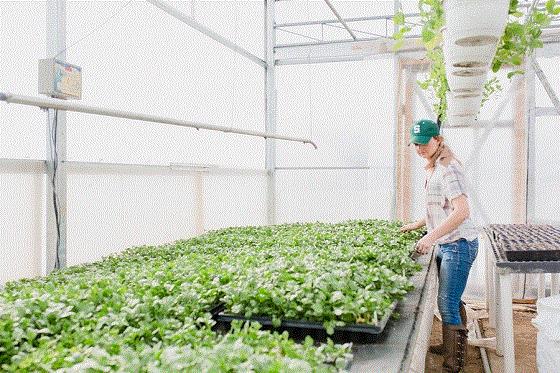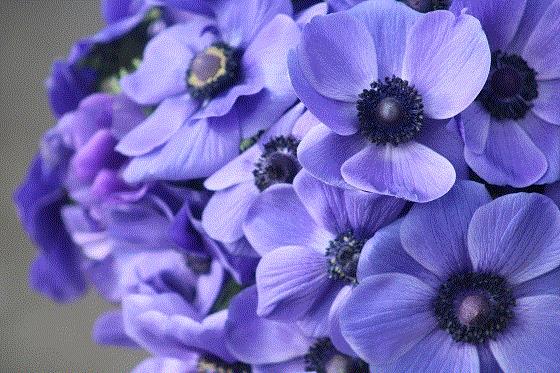An Ode to Snapdragons
Tater and I are knee deep in the spring season and are harvesting armloads of anemone, ranunculus, snapdragons and stock. Interestingly enough, we are noticing an uptick in demand for line flowers (tall flowers that give an arrangement height and width.) Not quite sure if it’s a residual effect of the cut flower supply chain or the fact that local snapdragons and stock have the most amazing fragrance and colors! Stock and snapdragons are florist staples, and if you are looking to add florists to your customer base, line flowers are a great way to get your foot in the door.
Before we get too carried away talking about snapdragons, I wanted to discuss stock. Stock always sells really well. Florists tell me that stock purchased from rewholesalers can have trouble rehydrating (be sure to check out FloraLife’s new website on stock) or come in with botrytis. Stock resent heat, like most brassicas do.
Tater and I just finished sowing our last succession for the season. For most folks it's getting late to have multiple sowings of stock. But you can still start snapdragons. Snapdragons are classified into Groups 1 through 4 based upon their flowering time, with 1 being the earliest and 4 being the latest. There are all sorts of different varieties of snapdragons that are bred to flower and flourish during different seasons of the year. The best part of snapdragon production is that you can get a lot of stems per square foot, making them a really profitable crop.
An armload of early season Antibes snapdragons.
If you have a soft spot for snapdragons like I do, you will want to either order seeds to start your own plants, or you can check with your favorite distribution company sales rep and see if plugs are available.
It is possible to direct sow snapdragons in the bed, but it's not recommended. They benefit from the extra TLC they get in the plug tray. If you are in the mood to try to start your own snapdragons be sure to start with clean plug trays and media. Young snapdragons have a very low tolerance for pathogens. Be sure to start clean and stay clean! Purchasing quality seed and having sterile growing conditions will give your snapdragon crop the best start possible.
Snapdragons need light to germinate, so do not cover the seed. Some growers put a light coat of vermiculite on their snapdragon trays to help keep the new seedlings from drying out, but Tater and I don’t use vermiculite. Instead, we programmed a time clock to run the mist multiple times per day to prevent them from drying out. If you do not have a mist system it may be worth trying a very light dusting of vermiculite.
I think you should consider adding snapdragons into your rotation, especially if you are in the wholesale market. As I mentioned before there are many awesome varieties of snapdragons, but be sure to select from the group that is appropriate for the season you will be harvesting. Some of our favorites to sow this time of year are Potomac and Opus. These are both in Group 4, since we will be harvesting them in the summer months. Be sure to sow multiple successions, because once your customers get a taste for local snapdragons, they will most certainly be back for more.
HERE is a link to a Potomac Snapdragon culture sheet from Pan American Seed. It’s a good primer for snapdragon production. Happy sowing!

Watching for Thielaviopsis
Speaking of plug production, here’s another critter to keep an eye out for: Thielaviopsis, also known as black root rot. It's a fungus that kills plant roots. And that's bad, because no roots = no flowers!
Many times, symptoms are mistaken for a nutrient deficiency—plants will turn yellow and over time the plant dies as a result of losing its roots. If you see discoloration of young plants in a random pattern in your propagation area or on plug trays, be sure to look at the roots. If the roots are black, there is a chance Thielaviopsis is the culprit. Bear in mind, if you have a nutritional issue, more than a handful of plants will have odd discoloration.
It’s important to inspect all plug trays coming into the farm for pathogens and critters. Theielaviopsis in particular is a challenge to eliminate once it establishes at the farm. Some crops are more susceptible than others; pansies in particular struggle with Thielaviopsis.
Click
HERE to see a photo from Cornell that shows
Thielaviopsis on pansies. Tater and I love growing cut pansies, which is why we mention it. Ranunculus, zinnias and marigolds struggle with this disease, too.
For those of you getting ready to plant out your ranunculus, keep an eye out for this. You don’t want to introduce
Thielaviopsis to your planting areas, so if you see diseased plants discard them immediately, do not compost. Be sure to thoroughly disinfect the trays, and benches the plants were on. Sanitation is critical! According to this
e-Gro alert, a 10% bleach solution works well on surfaces, tools and trays.
Thielaviopsis can live on unsterilized plug trays and infect your next crop, thus perpetuating the cycle!

Sterile media and plug trays give your ranunculus a strong start! We start our ranunculus is 50-cell plug trays and transplant into the greenhouse.
At the start of a new season we all have a ton of work to do! My point in mentioning Thielaviopsis is that cutting corners can have negative effects on your upcoming crop. Set yourself up for success and take the time to make sure your recycled trays are sterile! Or, for crops that are highly susceptible to Thielaviopsis, consider purchasing new trays.

Bugwood—a UGA Website!
Bugwood—commit it to memory! Bugwood is a really awesome website created and managed by the University of Georgia’s Center for Invasive Species and Ecosystem Health department. On this site you will find some excellent resources to help you identify weeds, insects and pathogens that you may run into on the farm.
I just learned about Bugwood this past week, and I look forward to consulting their pages when I have a mystery pest I need to identify. Bookmark the Bugwood URL (
www.bugwood.org/index.cfm) in case you need it. If you utilize this resource and work with your local floriculture extension agent, you should be on track to rectify any hiccups you run into during the season.
Check Out the Marketing Munchies Podcast
Looking to up your marketing game? If so, and if you are a podcast junkie like me, you should check out the Marketing Munchies podcast! My dear friend and mentor Dr. Bridget Behe of Michigan State University publishes this weekly podcast, which is geared towards green industry businesses. Dr. Behe has more than thirty years of green industry marketing experience and is a nationallty recognized green industry speaker and researcher.

In her podcast she highlights the latest in horticulture marketing and consumer research. Each episode is less than fifteen minutes in length, very straightforward, and is loaded with valuable information to help you level up your business.
You can stream the Marketing Munchies Podcast on Spotify or receive them directly to your inbox.
HERE is the link to her website, so you can subscribe. Trust me, you wont regret it!
P.S Tater and I were guests on this week’s podcast! Be sure to check it out!
What I Found on FloraLife's New Website
I want to bring your attention to a new industry resource. Earlier this month, Floralife launched their
NEW WEBSITE and one of the highlights is their new education section. Tater and I took some time this week to explore their Flower Library, and Flower Care and Handling resources.

Anemones are in full swing on the farm so it was fun to learn about the folklore behind their name. This is Anemone Carmel Blue.
As a grower, the Flower Library was especially fun to explore. Each flower highlighted on their website has a description including their Latin name, place of origin and design tips. They also have a quick guide on best handling practices for each crop. I really enjoyed looking at the anemone and ranunculus pages. I learned that "Ranunculus" in latin means "little frog," and that anemones were supposedly created from Aphrodite’s tears after her lover Adonis was killed. I never knew anemones had roots in Greek Mythology! So if you have time this week, explore their Flower Library. There’s some really fun information on their website.
Something else I learned: As you know, Tater and I sell exclusively to florists and event planners. It was interesting to learn about the handling process for anemones and ranunculus. When they aren’t sourced locally the florist may have challenges with rehydration and botrytis as a result of shipping. Exploring
FloraLife’s website gave me some valuable insight on the extra lengths our customers go through when certain flowers are out of season. It paints a better picture as to why locally grown anemones and ranunculus are so special.

In Closing
That’s all for this edition! Tater and I have to get back to cutting ranunculus and taking dahlia cuttings. If you have any cut flower topics you want us to write about, send an email to ldaschner@ballpublishing.com. Also, if you want to see Tater’s daily shenanigans, check out our Instagram @forgetmenotfarmsmi. Stay well and we will reconnect with you all soon!
Until next time,
Lindsay Daschner (and Tater)
Editor-at-Large—Bloom Beat
Owner—Forget-Me-Not Farms
This email was received by 4,237 of your fellow fresh-cut flower growers!
If you're interested in advertising in Bloom Beat, contact Kim Brown ASAP and she'll hook you up.